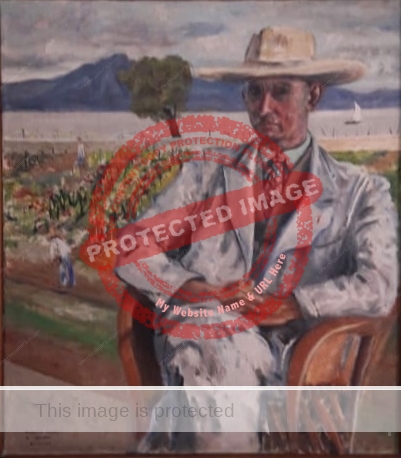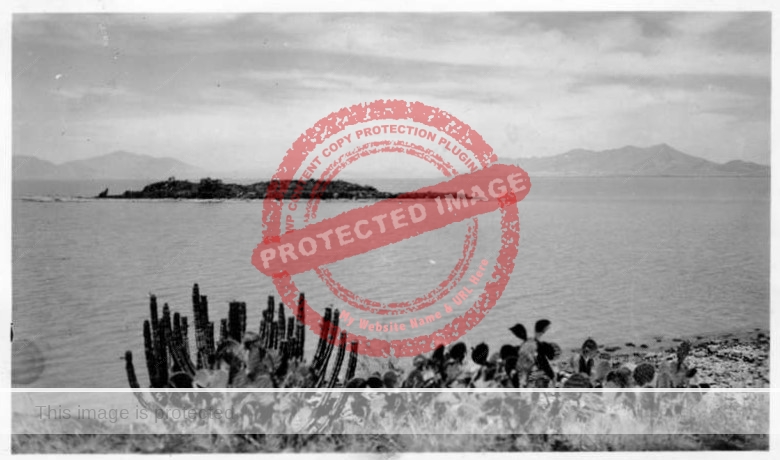Herbert and Georgette Johnson were almost certainly the earliest English couple to settle in Ajijic. They arrived in December 1939 and were fixtures of the local community for the next two decades.
The pioneering Johnsons acquired an extensive lakefront property one block east of the current pier and built a roomy single-story home in the local architecture style of adobe and tiles. The couple then created a stunning garden, extending down to the beach.

Otto Butterlin. 1943. Portrait of Herbert Johnson. Image courtesy of Milagros Sendis.
Herbert was a keen amateur photographer and documented the construction work via his camera. By a remarkable stroke of luck, I was gifted a photograph album in 2019 that once belonged to the Johnsons and had been found by chance at an estate sale in New York State. The 250 or so photographs it contains include approximately one hundred images of Ajijic, depicting construction of the house and garden, local scenery, streets, buildings, people and events. The album also includes photos taken on trips elsewhere in Mexico:
- Quinta Johnson, Ajijic
- Ajijic and area (1940s)
- Archaeological sites: Tenayuca, Teotihuacan and Xochicalco
- Xochimilco
- Horsemanship and bullfights (locations unknown)
- Trips in central and west Mexico
As an engineer, Herbert Johnson loved his gadgets, and the superb quality of these photographs, most of them from the 1940s, reflects his technical prowess with a camera. His photos of Ajijic are among the earliest known photographic images of the village.
Who was Herbert Johnson?
Johnson was quite an adventurer. As a teenager he helped lay cable in the Amazon; decades later, in retirement, he was the unofficial squire of Ajijic.
The son of a Cambridge-educated clergyman, Herbert Braithwaite Johnson, was born on 16 August 1877 in Lincolnshire, UK. At age 16, he left Harrow, one of England’s top private schools, to become an electrical engineer.
Johnson was likely already working for Siemens in 1895 when the company was contracted to lay telegraph cable along the Amazon, from Belem to Manaos. This massive undertaking, and the 18-year-old Johnson’s role in it, have been well documented by Bill Burns and James Catmur, a great-grandnephew of Johnson.
By November 1898, Johnson was back in London, and sponsored for student admission to The Institution of Electrical Engineers (formerly The Society of Telegraph Engineers). In his application, Johnson wrote that he was employed by Siemens Bros & Co., and was attending evening classes at the City and Guilds of London Institute in Finsbury. He was a student member of the IEE for three years before becoming an Associate Member in 1902 and a full Member in 1904, by which time he was living at 8, Quarry Road, Wandsworth. In 1905 he was fined £5 for riding his motorcycle too fast through the village of Cobham. By the 1920s, Johnson was the Resident Engineer at the Wandsworth Generating Station. He retained membership of the IEE until his retirement in 1930, the year he married Georgette Martin Wilkie.
The newly weds moved to Chinon, in the Loire Valley of France. In 1939, on the eve of the second world war, the Johnsons wisely decided to leave France and move to Mexico.
The unofficial squire of Ajijic
When the Johnsons arrived in Los Angeles, via the Panama Canal, in June 1939, they first headed north to visit a cousin in Canada and take a trip to Alaska. They then headed south, and crossed the border into Mexico on 5 December 1939. It is unknown how they first learned of Ajijic or precisely why they decided to make their home in the village. Within a couple of years, they had bought 5000 square meters of lakefront property (known informally as Quinta Johnson) and built their house, garden and orchard.

Ann Medalie. 1944. Ajijic. (Quinta Johnson)
The elaborate and colorful garden was painted and photographed by prominent artists, such as Ann Medalie (whose paintings of Ajijic were exhibited in Mexico City), and lavished with praise by visitors, including the Canadian writer Ross Parmenter. It even made it into Gardens of the World. In 1949 it was the setting for the marriage of Johnson’s 29-year-old niece, nurse Helen Eunice Riggall, and Canadian writer Harold Walter Masson. Their love story, one of the most endearing tales to emerge from my Ajijic research, is retold in Foreign Footprints in Ajijic.
Binoculars at the ready, Herbert took a paternal interest in all the comings and goings at the nearby pier. (At that time it was far easier to reach Ajijic from Chapala by boat than by road.) The foreign community in Ajijic was tiny when the Johnsons first arrived. But a combination of world events and personal misfortunes caused it to grow steadily during the 1940s.

Herbert Johnson. c 1944. Mezcala Island.
Having completed his house and gardens, Herbert Johnson used his engineering skills to help others. He oversaw the construction in San Antonio Tlayacapan, on a lot owned by Georgette, of a house which became the residence of Peter Lilley (one half of the Dane Chandos pen name responsible for House in the Sun and Village in the Sun). Author Sybille Bedford included references to both the Johnsons and Lilley in The Sudden View, her fictionalized account of traveling in Mexico.
In 1948, Johnson also helped Neill James design and build Quinta Tzintzuntzan, now part of the Lake Chapala Society complex, as she recounted in “Ajijic Carrousel”:
I was faced with building a casa for myself, an intriguing project. Herbert Johnson, Ajijic’s first English home-owner, a retired engineer, was a help to me… Herbert helped figure out the stress and strain of wooden and steel beams… He supervised the making of the reinforced cement ring with cutting edge used in digging my well.”
The Johnsons also fomented the nascent artistic community in the village. In December 1944, for instance, they held an exhibition of work by area artists and authors on the terrace of their home. The show included paintings, drawings and watercolors, plus embroidery work by village women.
In an unpublished manuscript, Neill James describes Herbert Johnson as a feudal lord whose list of all the foreigners living in Ajijic was divided into two columns: the sane and the crazy. The only sane ones were Johnson himself, Georgette and a couple from Scotland. All the others—including La Rusa, Louisa Heuer, James herself, and “Dane Chandos”—were crazy.
In the 1950s, the Johnsons’ guest cottage was rented by American artist Barbara Zacheisz.
Later occupants of Quinta Johnson, which was divided into three sections shortly after Herbert’s death, included Helen Kirtland. Kirtland’s daughter, Katie Goodridge Ingram, wrote a fascinating account of early life in Mexico City and Ajijic (in the 1940s and 1950s) in According to Soledad; memories of a Mexican Childhood.
The large metal cross on the lakeshore at the end of Calle Nicolas Bravo was originally erected by Herbert Johnson. It is one of the few remaining signs of the Johnsons’ long period residing in, and presiding over, the foreign community in Ajijic.
After Johnson died in 1960 and was laid to rest in the Ajijic cemetery, Georgette returned to live in England, where she died in 1975. When Georgette’s estate was finally settled in 1983, it was valued at only £5665.00. Apparently she must have known nothing about—or had no way of accessing—the several million dollars held by Herbert in the US, some of which was eventually claimed by, and distributed among, family members.
Family members visiting Mexico in 1973 successfully located Johnson’s grave marker. Looking somewhat improvised, and with an incorrect year of birth, it read “H. B Johnson / EX-HARROVIAN / ENGLAND / 1876-1960.”
Is it still there? If so, having it restored or replaced would be a long overdue tribute to this pioneering Englishman.
Acknowledgments
My sincere thanks to James Catmur, for sharing family photos and memories, to Bill Burns, and to Dr Kimberly Lamay Licursi for kindly entrusting the Johnson’s photo album to my care.
Chapter 9 of Foreign Footprints in Ajijic: Decades of Change in a Mexican Village is devoted to the Johnsons’ time in Ajijic. Several other chapters offer more details about the history of the artistic community in Ajijic.
Sources
- Sybille Bedford. 1953. The Sudden View: A Mexican journey. London: Victor Gollancz Ltd.
- Bill Burns. 2009, 2022. “History of the Atlantic Cable & Undersea Communications from the first submarine cable of 1850 to the worldwide fiber optic network.”
- James Catmur. 2023. “Tracing an ancestor down the Amazon!” IET Archives, 10 Jul 2023.
- Neill James. Undated. “Mexican Story.” Unpublished manuscript in the Neill James archive of the Lake Chapala Society.
——— 1967. “Ajijic Carrousel,” Guadalajara Reporter, 11 March 1967 - Elizabeth Schuler. 1964. Gardens of the World. London: MacDonald, 160–161.
- Surrey Comet (UK): 3 June 1905.
Comments, corrections or additional material related to any of the writers and artists featured in our series of mini-bios are welcomed. Please use the comments feature at the bottom of individual posts, or email us.
Tony Burton’s books include “Lake Chapala: A Postcard History” (2022), “Foreign Footprints in Ajijic” (2022), “If Walls Could Talk: Chapala’s historic buildings and their former occupants” (2020), (available in translation as “Si Las Paredes Hablaran”), “Mexican Kaleidoscope” (2016), and “Lake Chapala Through the Ages” (2008).
wow–love seeing how the lake looked then–